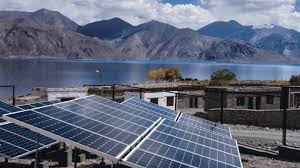GS3 – Environment

Context:
India plans its largest Hybrid Renewable Energy Park in Ladakh to accelerate clean energy targets, but the project raises concerns over the livelihood and culture of Changpa nomads.
Project Overview:
- Capacity: 13 GW hybrid park comprising:
- 9 GW solar
- 4 GW wind
- Battery storage facilities
- Regions: Pang, Debring, and Kharnak in Ladakh.
- Estimated Cost: ₹60,000 crore.
- Pilot Project: Solar Energy Corporation of India (SECI) has deployed a 25 MW solar-battery setup at Taru, Leh.
Key Concerns:
- Land & Livelihood:
- Overlaps with Changpa pastures in Changthang, vital for GI-tagged pashmina goat herding.
- Lack of formal land rights exposes nomads to displacement without compensation.
- Green Grabbing:
- Land appropriation under climate initiatives may violate UNDRIP principles protecting indigenous rights.
- Cultural & Ecological Risks:
- Worker influx may strain fragile Ladakhi ecology.
- Traditional pastoral practices and nomadic culture risk erosion.
Significance:
- Supports India’s renewable energy transition.
- Highlights the need for inclusive planning that balances energy goals with indigenous rights and cultural preservation.




